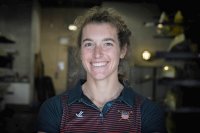"America is losing its battle against suicide by veterans and service members. And, as more troops return from deployment, the risk will only grow," writes Dr. Margaret C. Harrell and Nancy Berglass in a recent study commissioned by the U.S. Army, entitled "Losing the Battle."
The statistics are like a hard punch to the gut. From 2005-2010, it’s estimated that a service member took their own life at a rate of once every 36 hours. During the last two years of combat, more soldiers have died from suicide than those lost on the actual battlefield.
For Bob Nevins, a Vietnam veteran and former airline captain, the loss was simply unacceptable.
"I started reading the news and seeing quotes that indicated that not since Vietnam have suicides been at such high, record levels," said Nevins. "But this time," said Nevins, "I saw a solution."
With the help of local horse expert Marilyn Lane, Nevins sought to address the problem head on. Together and with the help of many individuals working behind the scenes (including Senator Kirsten Gillibrand and Congressman Chris Gibson), the duo have designed a unique and powerful solution, pairing soldiers struggling to readjust to civilian life with Thoroughbred horses also struggling to find a second career after their time has ended on the racecourse.
Based out of the horse stables off of Ruggles Road in Saratoga Springs, they call it Saratoga War Horse.
On paper, the program seems simple enough. Based on the works of Monty Roberts, who gained fame as a great and talented "horse whisperer," the program teaches soldiers to communicate with a horse using the equine’s own language, gaining its trust and friendship in a one-on-one hands-on exercise. In practice however, the experience has proved to be extremely powerful for participating veterans, opening them up to a new understanding and shift in perspective that helps them to feel grounded, able to finally start leaving their demons behind. Their words, not mine.
"You learn something new about yourself," said Trevor English, a local musician in Saratoga Springs who completed a tour in Afghanistan as a Maintenance Squad Leader for the U.S. Army’s Unmanned Aircraft Systems platoon for the 3rd Brigade, 10th Mountain Division, before his discharge in April of 2010. "It’s just amazing," he said, "indescribable. I couldn’t really explain how I felt, except that it was one of the greatest days of my life. It’s empowering."
* * *
During English’s first run through the Saratoga War Horse program in late November, a small group of veterans and interested parties were allowed to stand by:
English stands in the center of a medium-sized circular pen, leading in a large and powerful Thoroughbred. As instructed previously during the orientation for the program, English unclips the horse from its lead and tosses the rope behind it. The rope spurs the horse to action, running along the edge of the pen as it circles English. As English looks for subtle signs of communication from the animal
– a bowed head or the particular positioning of the ears –
the eyes of both man and horse lock. It’s a kind of tunnel vision, described English, where everything outside the pen suddenly disappears, becomes unimportant. The soldier in the center finds himself unexpectedly forced to live only in the present moment, putting aside years of baggage and emotional turmoil that minutes earlier seemed impossible to let go of. In the pen, between man and horse, there simply is no room for such things anymore.
English stops throwing the lead and the horse comes to a stop. Standing in the center, the Afghan vet is instructed to turn his back to the animal and wait. He doesn’t see the horse, said English, more like he feels its presence. The giant animal walks carefully up to the soldier and delicately places its nose on his shoulder. English is beaming, at a complete and utter loss for words. He’s made his connection, and his smile says all you need to know about just how moving and powerful his experience has been. * * * Since his first experience with Saratoga War Horse, English has decided to work closely with the program. With the help of Nevins, Lane, and instructor Melody Squier, English is hoping to become the program’s newest instructor, and has already had a chance to watch a few of his buddies step into the pen themselves. "The benefits of this program are so obvious to me," said English. "If I can help out in any way to relate my experience to other people who are going through the same sort of issues, I’m going to try and help however I can." Reaching a wide range of military veterans struggling to readjust to civilian life is exactly what Saratoga War Horse is all about. "We’re not a mom-and-pop operation," said Nevins, "and we’re not do-gooders. We’re trying to find a solution to this national tragedy of losing our young soldiers to suicide because nobody knows how to help them get through it. So we want Saratoga War Horse to serve as a model that can be used nationally so we can reach as many veterans as possible." To that end, the staff at Saratoga War Horse has enlisted the help of Veterans Affairs (VA) to conduct a scientific review of the program, giving it added weight, merit, value and eventually funding support. The program has already begun to turn some heads at the VA. "You’ve got me thinking on a multitude of different levels," said Col. Eric Olsen, a New York Army National Guard chaplain. Olsen has seen many men struggle after returning from combat. "A lot of these suicides are happening because these kids don’t really understand who they are once they’re through with their service," said Olsen. "But this can remind them of why they took that step in the first place
–
to better themselves. It reminds them of who they are."


























 How to resolve AdBlock issue?
How to resolve AdBlock issue? 









